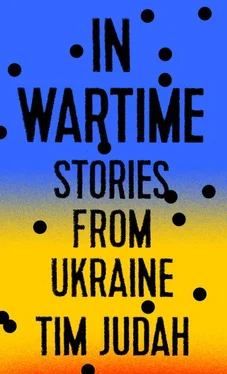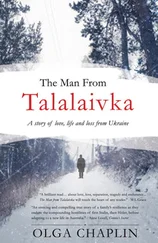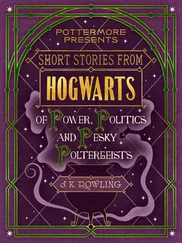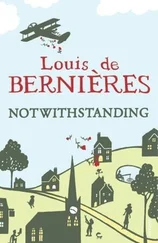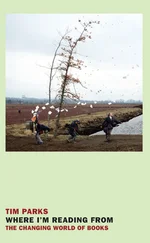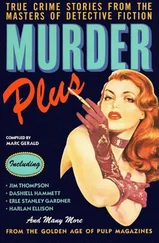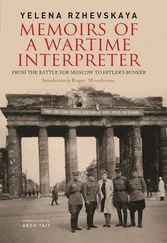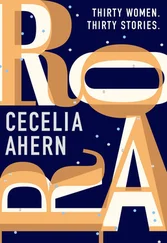In 1949, Roman, her sixteen-year-old brother, who had joined the UPA, was caught in their home village near Stryi. He was arrested and interrogated in a nearby house.
They treated him terribly and my mom heard all of his screaming. They tortured him and tried to force him to tell them about the insurgents. On the third day there was no more screaming to be heard. He was then thrown, half dead, into a car and driven to Stryi. In Stryi the car stopped on the square, right near the house where my sister Maria lived. She heard shouts of pain, looked through the window and recognized our brother and began to shout “Roman! Roman!”
The neighbors quickly moved her away from the window, realizing the danger she was in. Olha does not know where he was buried. She and two sisters joined the UPA, carrying messages and equipment and doing intelligence work. About the troops who were deployed to fight the UPA in what was a major counterinsurgency operation, she said that they were mainly Russians “but there were also traitors among the villagers who helped them. We called the Russians ‘Moscali.’” The word is still very much a derogatory term for Russians. Her sisters were caught and sent to the Gulag in Karaganda in distant Kazakhstan, returning after the death of Stalin, when, she recalls, many from there and Siberia also returned.
After the war Olha made a career for herself as a teacher of deaf and mute children. She was religious but after the war the local Greek Catholic Church, which had nurtured western Ukrainian nationalism, was banned by the Soviets. Priests were arrested and sent to the Gulag and its churches were handed over to the Russian Orthodox Church. Many priests who remained continued to serve their flocks, though in private. “We had an underground priest.” When you wanted to say confession or fix a baptism or any other such event, you would go to his house and ask him to come and visit on such and such a day. When he arrived at the block where you lived, someone would keep a watch out for “tails” to check if anyone was following him. In 1989, as part of Mikhail Gorbachev’s perestroika , the Church was legalized again.
Olha is a woman of strong views. The young people who went to the Maidan in 2014 and were the backbone of the revolution were the new generation that she had been waiting for. She thought nothing could be expected from generations who had known Soviet rule because, she said, she could see in herself how deep Soviet “slavishness” had “entered our souls.” Sometimes “I can spot Soviet thoughts in my head.” To explain herself and her idea of how oppressed and craven Ukraine had been, especially that part which had been Soviet since the revolution and civil war, she told an anecdote about Stalin. One day he gathered all his top men. “He took a chicken and it ran around. He caught it and began to pluck it until it was naked. Then it did not run around but leaned in on his leg, and he said: ‘Now you can do whatever you want with him.’” When the Holodomor started, “Stalin plucked all the feathers from Ukraine and those that remained alive were ready to do anything to stay alive.”
I asked her about the war and people in the east. “I don’t blame those people so much,” she said in a thoughtful tone. “They were brought up as animals. Their goal is just to eat and dress and they never saw God. They never had a thought of helping anyone and would be ready to sell their own mother for bread or a few coins.”
The UPA was a brutal organization, infused with anti-Semitism and hatred of Poles, though of course there were also instances of people saved by the UPA or those connected to it. The UPA wanted to create a Ukrainian state for Ukrainians and was a product of its time. Ironically, what its partisans had started—i.e., fighting Poles, who responded where they could with equal brutality—was a job finished by Stalin when he sent the Poles to Poland and brought Ukrainians to Ukraine. In the minds of many ordinary people in the west of Ukraine and indeed elsewhere, what is remembered is that the UPA wanted an independent state, nobly fought the communists when they returned in 1944 and defended Ukrainian villages from the Poles. The Nazis recruited police and militia forces and guards for Nazi death camps and egged on local anti-Semitism. Today, the evil is forgotten and the noble is played up. A prominent monument in the Lychakiv cemetery in Lviv commemorates the fallen of the Galicia Division which, seven weeks before it surrendered to the Allies in 1945, was renamed the Ukrainian National Army. Although some other nationalities served within its ranks, the Galicia Division was an overwhelmingly Ukrainian unit of the Waffen SS. After the war thousands of its men ended up in Britain, Canada and elsewhere. Some were volunteers, some were mobilized and some of those who fought alongside the Nazis were men who, like tens of thousands of Russians, joined them to escape their POW camps, where men were starving to death. Failing to untangle this poisonous legacy has proved to be a Ukrainian Achilles’ heel.
When Ukrainians waved the red and black flag of the UPA on the Maidan, what it represented was seldom explored by Western journalists. But for the Kremlin it proved a godsend—“proof” that Ukrainians are fascists and Nazis. Andreas Umland, a German academic who teaches in Kiev and is an expert on the far right in the post-Soviet space, says most Ukrainians regard it simply as a flag of freedom. They don’t know that the red and black stand for the concept of Blut und Boden —“blood and soil”—adopted by the Nazis. Granny Olha and Grandpa Mihailo have their memories, their prejudices and their understanding of what happened according to their own experiences, but younger Ukrainians have only the selective filterings of a confused post-Soviet history, which also varies across the country. In the east, one set of memories is propagated and in the west another, and in between there are regional variations. But there is a history war and one full of bitterness and prejudice. As Mihailo Romaniuk, the Lviv historian and admirer of the UPA, explained:
In the east of Ukraine they continue the Soviet historical tradition and in the west and center we began to study the documents on issues which were forbidden before, for example the UPA, the Greek Catholic Church and the Holodomor. People in the east literally don’t read. They don’t look for information, and don’t look for sources. So they don’t know the other version of history… they don’t recognize the Holodomor but parts of their family could have died in that famine!
Looking out of his window we could see a strange memorial to the Soviet past. At the end of the Soviet period a big new building was built for the local party. Now it is used by the local tax authority. In front of it a vast round redbrick edifice was constructed with an imposing helipad on top. Party officials had envisioned themselves coolly zipping in and out as they ran Lviv and the rest of the country. The building was never finished.
The bitterness of history in Lviv is nowhere better tasted than at the Lonskoho Street jail. On one side of the slightly run-down, classic late-Habsburg building is Stepan Bandera Street, which eventually leads to the huge memorial to him just outside the city center. Built in 1889–90, this was first an Austro-Hungarian gendarmerie barracks. Between the wars it became a Polish prison, then a Soviet one, then a Nazi one, then a Soviet one again. When Ukraine became independent it passed into the hands of its intelligence services, the SBU. Part of the building is now an ordinary police station, but the jail, empty since 1996, has been turned into a museum.
A casual visitor who did not read all the explanations in great detail would learn that this was a jail where the three totalitarian regimes—the Poles, the Nazis and the Soviets—imprisoned heroic Ukrainian nationalists. In the explanatory notes the Polish state is almost, but not quite, equated with the Nazis and the USSR. Most of the cells have been left as they were. Chicken wire remains in the stairwell, installed to stop prisoners throwing themselves over the bannisters and committing suicide. One cell has been reconstructed to show what a Soviet inspector’s office would look like. In another, arty portrait photos have been hung of elderly UPA veterans with captions in which they reminisce about things that happened to them. Another cell is set aside for Soviet memorabilia, with an emphasis on its barbed-wire frontiers, and yet another commemorates the Lviv heroes of the 2014 Maidan revolution.
Читать дальше
